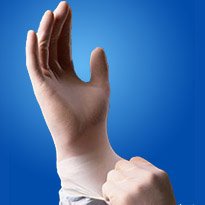| Greetings!
In this issue of the RDNews Judy Morgan starts out with a quiz about cross contamination. Read on for information and tips to avoid cross contamination in the dietary department. |
|
RD News |
Cross Contamination
 QUICK QUIZ QUICK QUIZ
Which of these practices are considered cross contamination?
The cook serves the meal at trayline wearing gloves, scoops the food on the plate using utensils and picks up the cornbread using a gloved hand and places it on the dinner plate.
The diet aid working the clean side of the dishroom puts away clean dishes and washes and sanitizes the carts and returns to put away the clean dishes.
The cook rinses the outside of a cantaloupe melon, places it on a cutting board and cuts the rind off the melon, discards it, and continues cutting the melon on the cutting board.
The diet aid wearing gloves and apron, delivers the traycart to the nursing station, uses the phone at the station to page cart delivery, returns to the kitchen and continues placing meal trays on the next cart for delivery.
 All of these All of these practices can be considered cross contamination. A nurse consultant that I was training on how to do a dietary department mock survey opened my eyes to some infection control and cross contamination issues seen from a nursing perspective. Per regulations and surveyor guidance, "Cross contamination refers to the transfer of harmful substances or disease-causing microorganisms to food by hands, food contact surfaces, sponges, cloth towels, or utensils which are not cleaned after touching raw food, and then touch ready-to-eat foods. Cross contamination can also occur when raw food touches or drips onto cooked or ready-to-eat food".
"Gloved hands are considered a food contact surface that can get contaminated or soiled. Failure to change gloves between tasks can contribute to cross-contamination". Hand washing is one of the best means of prevention and defense against cross contamination. Dietary staff need frequent reminders on the importance of, and when to wash hands. |
| RD Tip |
Hand washing and glove use should be one of the routine in-services given to the dietary staff. Refer to HMC P&P manual  Infection Control section, policy # 615 on hand washing when presenting the in-service to dietary. Staff frequently forget to wash hands between tasks because they think they are still working on "clean" tasks and don't realize all the potential opportunities for cross contamination. You may also invite the Director of Staff Development nurse to present a hand washing in-service to dietary staff to get a more clinical infection control perspective. Infection Control section, policy # 615 on hand washing when presenting the in-service to dietary. Staff frequently forget to wash hands between tasks because they think they are still working on "clean" tasks and don't realize all the potential opportunities for cross contamination. You may also invite the Director of Staff Development nurse to present a hand washing in-service to dietary staff to get a more clinical infection control perspective. |
| Dear Dietitians; |
Our long term care communities rely on our food safety expertise. We need to make sure we all practice what we  preach when we enter the dietary departments and put on those hairnets and stop at the hand washing sink before we go anywhere else in the kitchen! No cross contamination on our watch please.
Judy Morgan, MBA, RD |